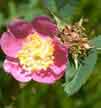




| Description | Distribution | Discussion | Horticultural Notes | Nomenclature | Links |

| As currently treated, the Pine Rose is apparently restricted to the open understory of native stands of Monterey Pine (Pinus radiata) from the Monterey Peninsula to Carmel Highlands, Waddell Creek near Año Nuevo State Park, and possibly Cambria as well. (NOTE: This distribution reflects a radically reduced circumscription of R. pinetorum as compared to most previous treatments. See R. bridgesii for Sierran material referred to by this name.) Additional distributional representations available from links at entry for this species in the Jepson Interchange for On-Line Floristics |
To further complicate the situation, the handful of populations currently identified as Rosa pinetorum exhibit greater morphological variation than would be logically expected in a single localized species. As a generality, plants are of medium height, with abundant straight prickles (both slender and thick-based) and multiple flowers with glabrous hips and pedicels. Significant variation occurs even on the Monterey Peninsula, with flower color ranging from light pink to nearly red, and prickles likewise varying in thickness. Plants from Cambria differ further in being relatively tall, and in fact approach the thicket-forming habit. Further studies are obviously called for, with one possibility being that the pine rose might have more in common with R. nutkana than with the other ground roses.